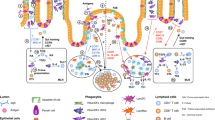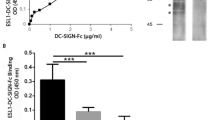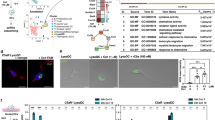Abstract
The importance of secretory IgA in controlling the microbiota is well known, yet how the antibody affects the perception of the commensals by the local immune system is still poorly defined. We have previously shown that the transport of secretory IgA in complex with bacteria across intestinal microfold cells results in an association with dendritic cells in Peyer’s patches. However, the consequences of such an interaction on dendritic cell conditioning have not been elucidated. In this study, we analyzed the impact of the commensal Lactobacillus rhamnosus, alone or associated with secretory IgA, on the responsiveness of dendritic cells freshly recovered from mouse Peyer’s patches, mesenteric lymph nodes, and spleen. Lactobacillus rhamnosus-conditioned mucosal dendritic cells are characterized by increased expression of Toll-like receptor regulatory proteins [including single immunoglobulin interleukin-1 receptor-related molecule, suppressor of cytokine signaling 1, and Toll-interacting molecule] and retinaldehyde dehydrogenase 2, low surface expression of co-stimulatory markers, high anti- versus pro-inflammatory cytokine production ratios, and induction of T regulatory cells with suppressive function. Association with secretory IgA enhanced the anti-inflammatory/regulatory Lactobacillus rhamnosus-induced conditioning of mucosal dendritic cells, particularly in Peyer’s patches. At the systemic level, activation of splenic dendritic cells exposed to Lactobacillus rhamnosus was partially dampened upon association with secretory IgA. These data suggest that secretory IgA, through coating of commensal bacteria, contributes to the conditioning of mucosal dendritic cells toward tolerogenic profiles essential for the maintenance of intestinal homeostasis.
This is a preview of subscription content, access via your institution
Access options
Subscribe to this journal
Receive 12 digital issues and online access to articles
$119.00 per year
only $9.92 per issue
Buy this article
- Purchase on Springer Link
- Instant access to full article PDF
Prices may be subject to local taxes which are calculated during checkout





Similar content being viewed by others
References
Cong Y, Feng T, Fujihashi K, Schoeb TR, Elsona CO . A dominant, coordinated T regulatory cell-IgA response to the intestinal microbiota. Proc Natl Acad Sci USA 2009; 106: 19256–19261.
Atarashi K, Tanoue T, Oshima K et al. Treg induction by a rationally selected mixture of Clostridia strains from the human microbiota. Nature 2013; 500: 232–236.
Brandtzaeg P . Gate-keeper function of the intestinal epithelium. Benef Microbes 2013; 4: 67–82.
Probst HC, Muth S, Schild H . Regulation of the tolerogenic function of steady-state DCs. Eur J Immunol 2014; 44: 927–933.
Pabst O . New concepts in the generation and functions of IgA. Nat Rev Immunol 2012; 12: 821–832.
Rogier EW, Frantz AL, Bruno ME et al. Secretory antibodies in breast milk promote long-term intestinal homeostasis by regulating the gut microbiota and host gene expression. Proc Natl Acad Sci USA 2014; 111: 3074–3079.
Mathias A, Pais B, Favre L, Benyacoub J, Corthesy B . Role of secretory IgA in the mucosal sensing of commensal bacteria. Gut Microbes 2014; 5: 688–695.
Peterson DA, Planer JD, Guruge JL et al. Characterizing the interactions between a naturally primed immunoglobulin A and its conserved Bacteroides thetaiotaomicron species-specific epitope in gnotobiotic mice. J Biol Chem 2015; 290: 12630–12649.
Cerutti A, Chen K, Chorny A . Immunoglobulin responses at the mucosal interface. Annu Rev Immunol 2011; 29: 273–293.
Corthésy B . Multi-faceted functions of secretory IgA at mucosal surfaces. Front Immunol 2013; 4: 185.
Crottet P, Corthésy B . Secretory component delays the conversion of secretory IgA into antigen binding competent F(ab)’2: a possible implication for mucosal defense. J Immunol 1998; 161: 5445–5453.
Boullier S, Tanguy M, Kadaoui KA et al. Secretory IgA-mediated neutralization of Shigellaflexneri prevents tissue destruction by down-regulating inflammatory circuits. J. Immunol 2009; 183: 5879–5885.
Slack E, Balmer ML, Macpherson AJ . B cells as a critical node in the microbiota-host immune system network. Immunol Rev 2014; 260: 50–66.
Rey J, Garin N, Spertini F, Corthesy B . Targeting of secretory IgA to Peyer's patch dendritic and T cells after transport by intestinal M cells. J Immunol 2004; 172: 3026–3033.
Kadaoui KA, Corthésy B . Secretory IgA mediates bacterial translocation to dendritic cells in mouse Peyer's patches with restriction to mucosal compartment. J Immunol 2007; 179: 7751–7757.
Rol N, Favre L, Benyacoub J, Corthésy B . The role of secretory immunoglobulin A in the natural sensing of commensal bacteria by mouse Peyer'spatch dendritic cells. J Biol Chem 2012; 287: 40074–40082.
Zheng SG, Wang JH, Stohl W et al. TGF-beta requires CTLA-4 early after T cell activation to induce FoxP3 and generate adaptive CD4+CD25+ regulatory cells. J Immunol 2006; 176: 3321–3329.
Sun CM, Hall JA, Blank RB et al. Small intestine lamina propria dendritic cells promote de novo generation of Foxp3 T reg cells via retinoic acid. J Exp Med 2007; 204: 1775–1785.
Coombes JL, Powrie F . Dendritic cells in intestinal immune regulation. Nat Rev Immunol 2008; 8: 435–446.
Chieppa M, Rescigno M, Huang AY, Germain RN . Dynamic imaging of dendritic cell extension into the small bowel lumen in response to epithelial cell TLR engagement. J Exp Med 2006; 203: 2841–2852.
Murphy KM, Heimberger AB, Loh DY . Induction by antigen of intrathymic apoptosis of CD4+CD8+TCRlo thymocytes in vivo. Science 1990; 250: 1720–1723.
Phalipon A, Cardona A, Kraehenbuhl JP, Edelman L, Sansonetti PJ, Corthésy B . Secretory component: a new role in secretory IgA-mediated immune exclusion in vivo. Immunity 2002; 17: 107–115.
Mathias A, Corthésy B . Recognition of gram-positive intestinal bacteria by hybridoma- and colostrum-derived secretory immunoglobulin A is mediated by carbohydrates. JBiolChem 2011; 286: 17239–17247.
Atarashi K, Nishimura J, Shima T et al. ATP drives lamina propria Th17 cell differentation. Nature 2008; 455: 808–812.
Mathias A, Duc M, Favre L, Benyacoub J, Blum S, Cortheesy B . Potentiation of polarized intestinal Caco-2 cell responsiveness to probiotic complexed with secretory IgA. J Biol Chem 2010; 285: 33906–33913.
Manicassamy S, Ravindran R, Deng J et al. TLR2 dependent induction of vitamin A metabolizing enzymes in dendritic cells promotes T regulatory responses and inhibits TH-17 mediated autoimmunity. NatMed 2009; 15: 401–409.
Jiang X, McClellan SA, Barrett RP, Zhang Y, Hazlett LD . Vasoactive intestinal peptide down regulates proinflammatory TLRs while upregulating anti-inflammatory TLRs in the infected cornea. J Immunol 2012; 189: 269–278.
Wang P, Hou J, Lin L et al. Inducible microRNA-155 feedback promotes type I IFN signaling in antiviral innate immunity by targeting suppressor of cytokine signaling 1. J Immunol 2010; 185: 6626–6233.
Oshima N, Ishihara S, Rumi MA et al. A20 is an early responding negative regulator of Toll-like receptor 5 signalling in intestinal epithelial cells during inflammation. Clin Exp Immunol 2009; 159: 185–198.
Heid CA, Stevens J, Livak KJ, Williams PM . Real time quantitative PCR. Genome Res 1996; 6: 986–994.
Cerovic V, Jenkins CD, Barnes AG, Milling SW, MacPherson GG, Klavinskis LS . Hyporesponsiveness of intestinal dendritic cells to TLR stimulation is limited to TLR4. J Immunol 2009; 182: 2405–2415.
Davies JM, MacSharry J, Shanahan F . Differential regulation of Toll-like receptor signaling in spleen and Peyer's patch dendritic cells. Immunology 2010; 131: 438–448.
Sansonetti P . To be or not to be a pathogen: that is the mucosally relevant question. Mucosal Immunol 2011; 4: 8–14.
Qin J, Qian Y, Yao J, Grace C, Li X . SIGIRR inhibits interleukin-1 receptor- and toll-like receptor 4-mediated signaling through different mechanisms. J Biol Chem 2005; 280: 25233–25241.
Zhang G, Ghosh S . Negative regulation of toll-like receptor-mediated signaling by Tollip. J Biol Chem 2002; 277: 7059–7065.
Kinjyo I, Hanada T, Inagaki-Ohara K et al. SOCS1/JAB is a negative regulator of LPS-induced macrophage activation. Immunity 2002; 17: 583–591.
Molenaar R, Knippenberg M, Goverse G et al. Expression of retinialdehyde dehydrogenase enzymes in mucosal dendritic cells and gut-draining lymph node stromal cells is controlled by dietary vitamin A. J Immunol 2012; 186: 1934–1942.
Diana J, Moura IC, Vaugier C et al. Secretory IgA induces tolerogenic dendritic cells through SIGNR1 dampening autoimmunity in mice. J Immunol 2013; 191: 2335–2343.
Fagarasan S, Muramatsu M, Suzuki K, Nagaoka H, Hiai H, Honjo T . Critical roles of activation-induced cytidinedeaminase in the homeostasis of gut flora. Science 2002; 298: 1424–1427.
Peterson DA, McNulty NP, Guruge JL, Gordon JI . IgA response to symbiotic bacteria as a mediator of gut homeostasis. Cell Host Microbe 2007; 2: 328–339.
Mowat AM . Anatomical basis of tolerance and immunity to intestinal antigens. Nat Rev Immunol 2003; 3: 331–341.
Shibolet O, Podolsky DK . TLRs in the gut. IV. Negative regulation of Toll-like receptors and intestinal homeostasis: addition by substraction. Am J Physiol Gastroenterol Liver Physiol 2007; 292: G1469–G1473.
Chinen T, Komai K, Muto G et al. Prostaglandin E2 and SOCS1 have a role in intestinal immune tolerance. NatCommun 2011; 2: 190.
Liew FY, Xu D, Brint EK, O'Neill LA . Negative regulation of Toll-like receptor-mediated immune responses. Nat Rev Immunol 2005; 5: 446–458.
Sato A, Hashiguchi M, Toda E, Iwasaki A, Hachimura S, Kaminogawa S . CD11b+Peyer’s patch dendritic cells secrete IL-6 and induce IgA secretion from naive B cells. J Immunol 2003; 171: 3684–3690.
Macpherson AJ, Geuking MB, Slack E, Hapfelmeier S, McCoy KD . The habitat, double life, citizenship, and forgetfulness of IgA. Immunol Rev 2012; 245: 132–146.
Fink LN, Frøkiaer H . Dendritic cells from Peyer's patches and mesenteric lymph nodes differ from spleen dendritic cells in their response to commensal gut bacteria. Scand J Immunol 2008; 68: 270–279.
Christensen HR, Frøkiaer H, Petska JJ . Lactobacilli differentially modulate expression of cytokines and maturation surface markers in murine dendritic cells. J Immunol 2002; 168: 171–178.
Sander LE, Davis MJ, Boekschoten MV et al. Detection of prokaryotic mRNA signifies viability and promotes immunity. Nature 2011; 474: 385–389.
Lathrop SK, Bloom SM, Rao SM et al. Peripheral education of the immune system by colonic commensal microbiota. Nature 2011; 478: 250–254.
Acknowledgements
We acknowledge support from the Swiss Science Research Foundation (grants Nos. 3100-138422 and 3100-156806 to B.C.). The commensal bacterial strain LPR was kindly provided by Nestlé Research Center, Vers-chez-les-Blanc, Switzerland. We thank Dr Gilles Bioley for critical reading of the manuscript.
Author information
Authors and Affiliations
Corresponding author
Rights and permissions
About this article
Cite this article
Mikulic, J., Longet, S., Favre, L. et al. Secretory IgA in complex with Lactobacillus rhamnosus potentiates mucosal dendritic cell-mediated Treg cell differentiation via TLR regulatory proteins, RALDH2 and secretion of IL-10 and TGF-β. Cell Mol Immunol 14, 546–556 (2017). https://doi.org/10.1038/cmi.2015.110
Received:
Revised:
Accepted:
Published:
Issue Date:
DOI: https://doi.org/10.1038/cmi.2015.110
Keywords
This article is cited by
-
A new generation of mesenchymal stromal/stem cells differentially trained by immunoregulatory probiotics in a lupus microenvironment
Stem Cell Research & Therapy (2023)
-
The panda-derived Lactiplantibacillus plantarum BSG201683 improves LPS-induced intestinal inflammation and epithelial barrier disruption in vitro
BMC Microbiology (2023)
-
Enhanced IgA coating of bacteria in women with Lactobacillus crispatus-dominated vaginal microbiota
Microbiome (2022)
-
IL-10 and TGF-ß1 Cytokines Stimulated by Ascaris lumbricoides Body Fluid Are Associated with Secretory IgA Levels Against Other Intestinal Pathogens Attenuating Diarrheal Symptoms
Indian Journal of Pediatrics (2021)
-
Selective involution of thymic medulla by cyclosporine A with a decrease of mature thymic epithelia, XCR1+ dendritic cells, and epithelium-free areas containing Foxp3+ thymic regulatory T cells
Histochemistry and Cell Biology (2021)



